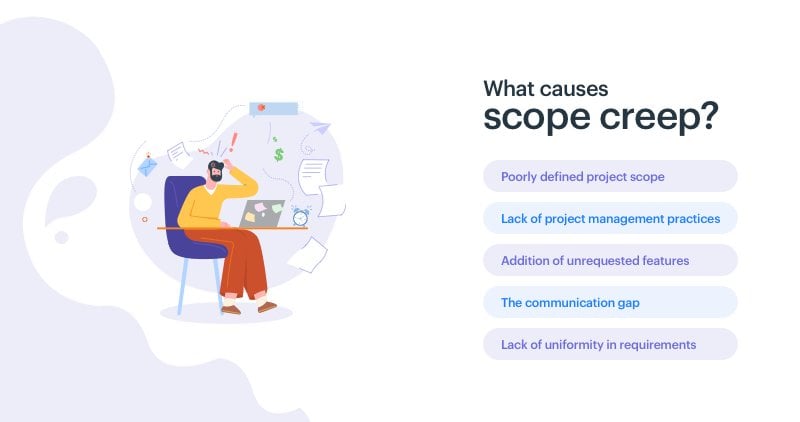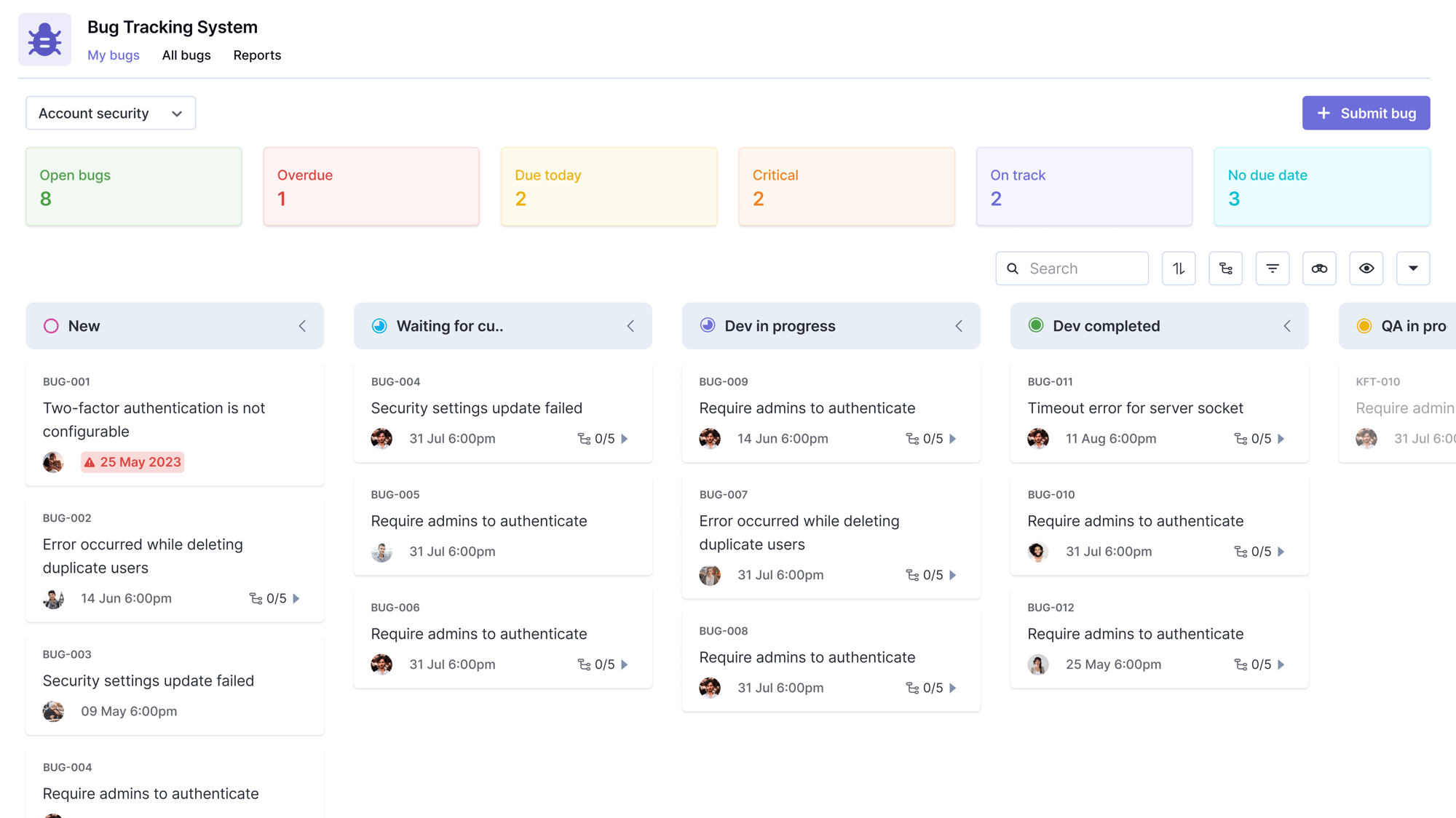Imagine you run a small bakery. There’s an order for a birthday cake that needs to be delivered in a day. You get all the ingredients and begin preparing the cake batter. After a few hours, you get a call from the same customer asking for a strawberry frosting on the cake. You agree because you haven’t baked the cake yet.
You get another call from the customer asking for a three-tier cake. Then another call telling you to put mickey mouse on the top. And then another to put a ‘Happy Birthday Matt’ on the side. You begrudgingly agree despite knowing that the delivery time has become short and it’s going to cost you a little more than the originally agreed-upon price.
So, what went wrong here?
The scope of the project was not clearly defined at the beginning and the baker accommodated small changes without modifying the budget or the expected timeline. This is called scope creep and project managers deal with this all the time while managing projects.
What is scope creep?
Scope creep is defined as a subtle deviation of the project from the original scope through the addition of new features. It starts with a very small change request that you don’t mind doing. These requests slowly start to pile up and ultimately lead to huge problems.
In project management, to understand the real meaning of scope creep, it’s important to know the meaning of scope in a project. The PMBOK Guide defines scope as “the extent of what a project will produce and the work needed to produce it.”

According to PMI’s The pulse of profession 2018, 52% of all projects face scope creep in one way or another. Another concerning factor is that seven years ago, the percentage of projects affected by scope creep was 43%. You can see that rather than decreasing, the percentage is actually ‘creeping’ up.
How does scope creep look like?
Scope creep is more common within project teams than you might realize:
- A delay of 54 weeks in opening a city library was blamed on a substantial number of last-minute changes in the architecture plan.
- The luggage handling system at Denver Airport failed to be completed on time because key stakeholders were not consulted in time, and their feedback had to be incorporated during execution.
When the Chrysler PT Cruiser was launched, aspects of how cars would be delivered to dealerships in time were not considered. This led to massive delays and customers shifting to other makers. Every aspect of a project left unaddressed initially is an opportunity for scope creep.
What causes scope creep?
There are numerous reasons why the scope of a project changes. Small changes in the requirements eventually snowball into new features. Another reason can be the change in the management of the clients’ company. An example of scope creep is that there are times when clients do not explain their vision properly which may lead to the project manager failing to specify the project scope properly.
Most of the causes of this deviation can be avoided if project managers improve their task management. The results of adopting better project management practices are evident in the PMI’s Pulse of Profession 2018. Organizations with a high level of maturity and better practices successfully avoided scope creep in their projects.
The percentage of projects getting affected was 33% in Organizations with people having better project management skills, which is an impressive feat.
Let’s look at the most common causes for the scope creep in projects are:

Poorly defined project scope
Lack of effective project management communication between the project manager and the clients is usually the biggest hurdle in scope creep risk mitigation. When a project manager does not understand the requirements clearly, the final product will be entirely different from the client’s vision.
Sometimes clients are also to blame, especially creative projects. They often do not have a clear vision of what they want, which leads to more confusion. Statements like “I’ll know when I see it” are a headache for project collaboration between teams.
Lack of project management practices
Adopting and strictly adhering to project management practices is a tried-and-tested method of preventing scope creep from dismantling your entire project.
Suppose the client asked you for a simple change during a kickoff meeting and you know it would only take you an hour to do that. So naturally, you won’t think of recording that change, but these things accumulate over time and can cause project delays.
Another factor that may cause problems is the lack of a centralized project management process. When everything is done haphazardly, you’ll miss something in the end.

Want to learn project management but put off by jargon?
Learn what's important in the simplest ebook for non-project managers.
Download NowAddition of unrequested features
Project teams sometimes start to focus on adding additional features in order to impress the clients. This may backfire if the project is required to be completed in a very short period.
Spending time on extra features means you either performed below par on a necessary feature or you won’t have time to complete it, which will ultimately cause unwanted delays.
The communication gap between project stakeholders
Another huge cause of unauthorized changes in a project’s objectives is the communication gap between the project stakeholders. Clients often do not respond quickly to the project team’s emails or phone calls. Similarly, there are times when the project runs into a bottleneck and there is a need to expand the scope.
However, without any input from the clients, the decision falls solely on the project teams. This leads to unapproved changes that the client may not like.
And don’t forget to try our Free and Customizable Templates:
– Marketing Plan Template to Streamline your Marketing Efforts
Lack of uniformity in the client’s requirements
‘Too many chefs spoil the broth’ and that is indeed the case with ongoing projects. If the clients assign multiple people to run points on the project, they’ll each have a different vision and that would ultimately create major confusion. Similarly, giving major decision powers to multiple members of the project team can also lead to issues. Giving a certain level of autonomy to the team members is good for the project but as a manager, it’s your job to set the limits.
While these issues are quite hard to avoid, there are several steps you can take to ensure that you are in control and the effects of scope creep remain at a minimum.
Why project scope creep is bad?
Project scope creep is usually disastrous for a project but there are instances when diverging from the original plan becomes acceptable. Since many projects run over the course of several years, there can be changes in the market dynamics or in the customers’ requirements which causes the project scope to expand.
Few issues that are caused by scope creep are,
- Lack of communication
- Lack of experience in project scope
- Poor goal setting
Can scope creep be a good thing?
It is important to know that you cannot completely eliminate scope creep from your projects. Customers’ demands might change in the middle of the project. So you should always be prepared for some changes which act as an advantage.
The following are some of the advantages of scope creep in an organization:
Improves customer retention
Accommodating change requests means your team is going above and beyond for a customer. This improves your reputation in the market and not only generates new customers but also ensures that the previous customers return to you for future projects.
Ensures market compatibility
When your features are frequently getting updated, your final product will be able to meet the requirements of the market easily. But changes must be according to the given project constraints and changes must be reflected in the updated deadlines and budget.
Increases revenue
If your company charges clients on a per-hour basis or your rates are according to the deliverables demanded. Change requests can mean an increase in the revenues of your company.
Optimizes the team’s processes
The increase in the project’s objective can also mean a learning opportunity for your team. For the next time, you can optimize your internal processes in order to reduce scope creep in the future.
Why proactively address scope creep?
Being proactive in addressing scope creep is crucial because
- it can lead to significant cost overruns,
- it can cause a breakdown in team communication,
- it can lead to inefficient time management in the team,
- it can cause quick burnout within the team, and,
- It can lead to a lack of clarity over final deliverables.
As is evident, scope creep can exact a severe toll in terms of both productivity and wellbeing within a project team. This makes it critical to address the causes of scope creep well before a project is executed.
Scope creep vs scope change vs scope gap
Scope creep is an unofficial, gradual scope change. Due dates and budgets are not appropriately changed, which can lead to dissatisfaction or even project failure.
Scope change is when both the client and the project manager officially decide to change the scope of the project, add a project feature or expand a functionality, for example. It is controlled and involves adjustments to budgets, timelines, and resources.
Scope gap happens when the project team’s understanding of the scope and the client’s expectations do not match. It’s a common problem in non-agile projects because the scope is often considered fixed. Agile projects expect the scope to change and since the development is iterative, scope gaps can’t exist beyond a single iteration.
How to avoid and manage scope creep
You can’t avoid scope creep completely and in some cases, a small deviation from the original plan is necessary for the success of the project. You can handle scope creep in the project where the goal of the project manager should be to manage scope creep in such a way that ensures the success of the project and leaves the clients satisfied with your service.
Because if you keep saying no to every single request by the clients, I guarantee that they will not return. The 5 tips that can avoid and mitigate scope creep in project management are:

1. Be proactive
In order to stay ahead, you must be vigilant from the first day. During the project plan, be sure to involve all the stakeholders to make sure that everything is clear.
Similarly, it’s also better to ask the clients to come up with a project charter and a list of features in order in order to better understand their vision.
2. Prioritize your tasks
It is very important to come up with a list of critical tasks that must be completed in order to finish the project. A priority list is so important that many modern project management methodologies require it.
By prioritizing tasks, you can also keep your team in check and prevent them from wasting time by focusing on unimportant tasks.
3. Put a price on it
Another way of reducing the number of change requests is to charge for additional features. This will not only increase your revenue but also discourage unnecessary change requests.
Similarly, a zero-sum game can also be a smart option. If a feature is being added to the project charter, be sure to get something out. This will keep the time and resources you’ll need to spend on a particular project constant.
4. Take help from technology
Modern projects cannot be completed successfully without help from technology. And no, I don’t mean spreadsheets because they’ll make your job harder. There are project management tools that can significantly enhance the performance of your team.
See why spreadsheets are terrible to manage projects and why you need a spreadsheet alternative.
5. Learn when to say no
It’s important for a project manager to be able to stand up to stakeholders and reject change requests when the situation demands them. You must explain to them the effects certain changes would have on the entire project.
Ask for an extension in the deadline if too many changes are requested. Effective communication with clients early can save you from a lot of problems at a later stage.
How Kissflow Project can help you tackle scope creep
Many of your project management challenges, especially scope creep, can be overcome with capable and efficient online project management software.
Kissflow Project can be the solution for you!
- is simple and intuitive to use,
- frees you from constantly tracking teammates,
- offers multiple views to visualize projects
- provides “Done”, “In-Progress”, and “On Hold” states for clarity on status,
- gives you access to powerful reports to make data-driven decisions, and
- reminds you when tasks near their deadlines.
As is evident, this project tool is all about giving you clarity around your project right from the get-go. Having all stakeholders on the same page right from the planning stage of a project is critical to getting the better of scope creep.
There’s a whole lot more to Kissflow Project. Sign up for free today to get acquainted with its simple yet powerful capabilities!
Start using the Kissflow Platform today to enhance your project management efficiency.
Your search for Project management has landed you here. Wondering why?
As a user, you'll experience the full value of Kissflow by implementing it across departments for diverse use cases rather than just addressing isolated needs like a project management tool for a single team or department.

%20(2).png?width=2000&name=PSE%20Dashboard%20(3)%20(2).png)
.png?width=2000&name=Dashboard%20(5).png)





